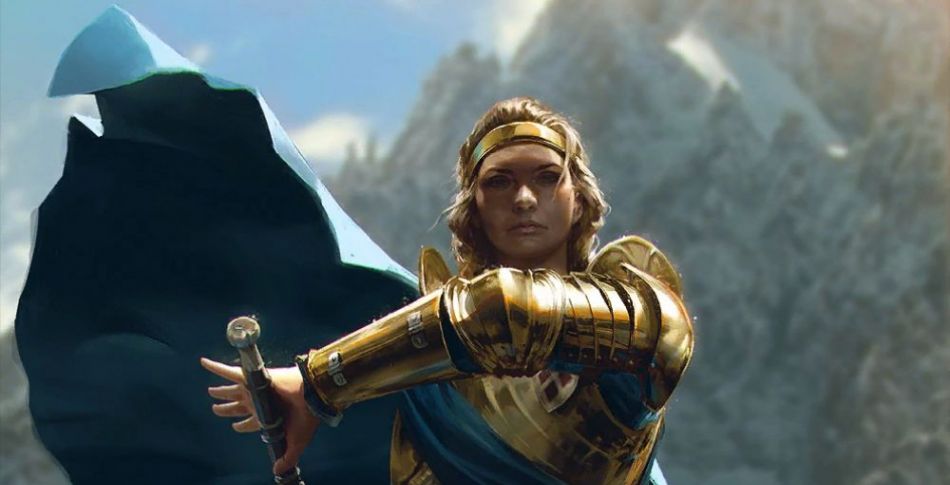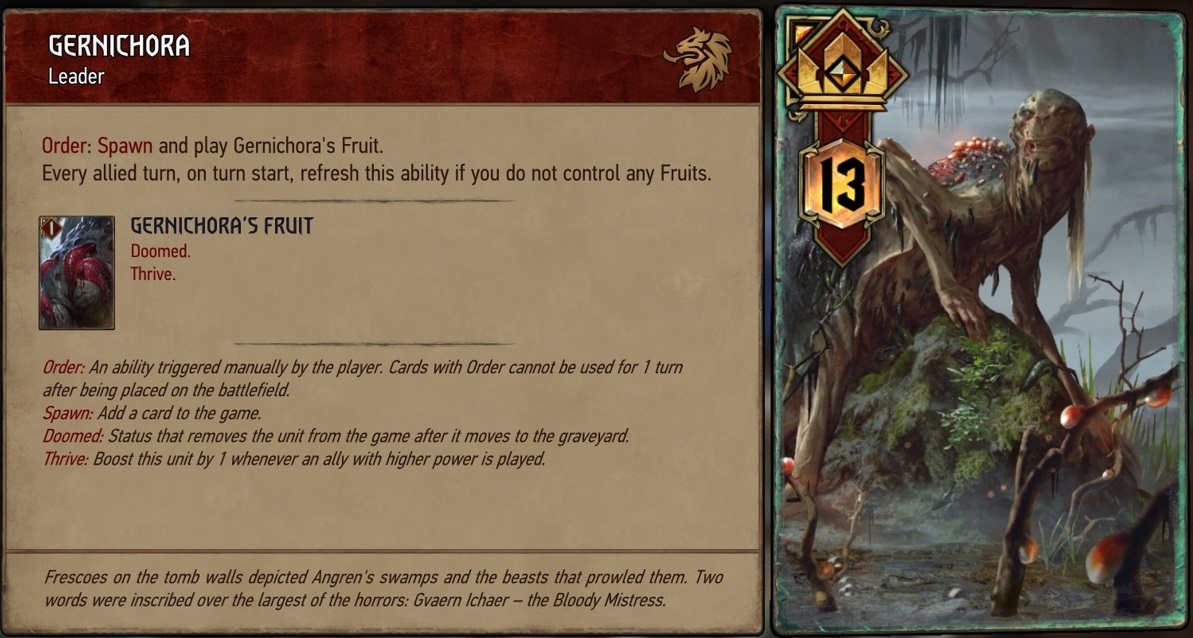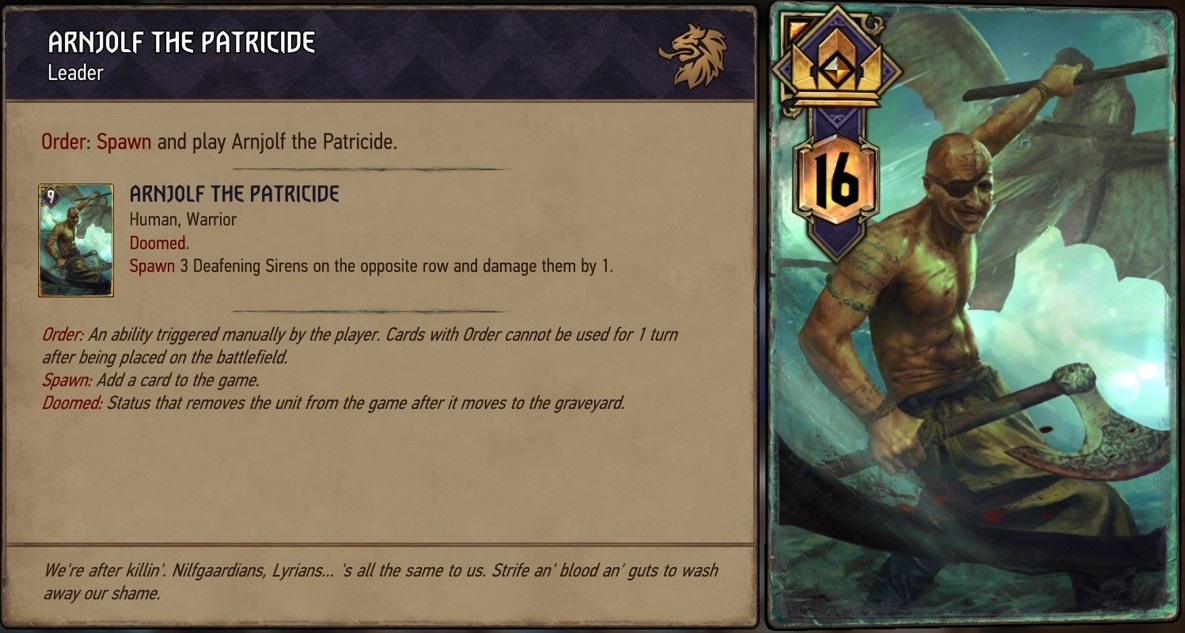

Rapid Reaction: Gwent's New Leaders and How They Can See Play
In July 2018, I laid out a synergy-value-leverage model for analyzing Gwent leaders. While the arrival of Homecoming has made the specific information in that article obsolete, the model remains valid, and the assessments made at the time are still useful for seeing how a leader can find a place in the metagame or fail to do so.
The synergy-value-leverage model assesses the strengths of leaders on three dimensions:
- Synergy, how a leader allows a deck to fulfill a specific plan
- Value, how a leader gives a deck pure point value
- Leverage, how a leader can interfere with the opposing deck's plan
These three dimensions also roughly correspond to the common Gwent deck strategies: greed (synergy), point-slam (value), and control (leverage).
Monsters: Gernichora
Monsters already had three synergy leaders (Arachas Queen, Eredin Bréacc Glas, and Unseen Elder) plus one value leader (Woodland Spirit). This distribution creates an obvious void for a leverage leader.

Gernichora, however, is not in any sense a leverage leader. Instead she is one of the purest value leaders in the game, with her Order ability spawning a one-point Gernichora's Fruit unit with Thrive so long as her controller has no units by that name. Because Gernichora can spawn a new Gernichora's Fruit and restart the Thrive chain whenever the previous Fruit is destroyed, the opponent has little incentive to destroy the Fruit except in last-to-act situations, creating a reliable source of points each round.
Thrive-based bronze cores are nothing new in Monsters decks, though usually as supplements to other plans, as in Big Woodland decks. Can the split-between-rounds value of Gernichora make her worth running over Woodland Spirit, especially with her low total provision count of 163? Skepticism is high, but time will tell.
Nilfgaard: Ardal aep Dahy
Nilfgaard's existing leaders cover all three dimensions: synergy (Emhyr var Emreis), value (Jan Calveit), and leverage (Usurper). Morvran Voorhis splits its strength between Reveal synergy and six points of pure value, a number that could go significantly higher before the December 2018 update.

Ardal aep Dahy combines value and leverage with his unique ability. Seizing an enemy with 3 or less power has a decent ceiling on its own, not only providing a six-point value swing but disrupting Deathwish chains (Harpy Egg), Order-based engines (Kaedweni Revenant), and more. Adding Tactics to one's deck opens up the possibilities even more; imagine running eight Tactics and being able to Seize a five-point unit such as Botchling right at the start of a round!
Ardal aep Dahy creates a delightful game-within-a-game, as the opponent must guess how many Tactics the player is running and plan accordingly. Are five-point units safe? What of four-point units? The inevitable refinement of the metagame will eventually generate a "correct" Ardal aep Dahy list, one with eight Tactics or four or zero, and this game-within-a-game will go away. Still, it will be fun while it lasts.
Northern Realms: Queen Meve
Northern Realms's existing leaders cover all three dimensions: synergy (King Demavend III and King Foltest), value (King Henselt), and leverage with a strong value element and a synergy finisher (Princess Adda). There is no particular pressure on the new leader to fit into any one category.

Queen Meve has a deceptively simple ability, boosting an ally by one point with a two-turn cooldown. At first, she simply seems like a mirror twin of Crach an Craite, boosting friends instead of damaging foes. Of course, existing Northern Realms decks already exploit the boost-based synergy between Tridam Infantry and Anna Strenger, and Meve's Leader Spotlight video highlights those two cards.
How far can a Queen Meve deck take the boost theme, though? Lyrian Scytheman? Lyrian Landsknecht? Temerian Infantry? With so many bronze Northern Realms cards holding so much promise, expect Gwent's best deckbuilding minds to give Queen Meve more than cursory attention.
Scoia'tael: Eldain
Most of Scoia'tael's existing leaders blend elements of multiple dimensions. Brouver Hoog and Eithné combine leverage with a significant value component (significant enough to be powered down in the December 2018 update in Eithné's case), while Filavandrel aén Fidháil provides obvious value yet has synergy with "already boosted" cards. Only Francesca Findabair falls squarely in one dimension, synergy.

Eldain continues the Scoia'tael multiple-dimension trend as a synergy-value leader focused on Traps. Without Traps in one's deck, he is utterly useless, but any deck that can play and then spring three Traps will unlock nine points of value (three Elven Deadeyes at three power each) over the course of a game. Choosing the right moment to activate Eldain's ability will be crucial for success, and the strength of Traps themselves, rather than anything Eldain as a leader can do, will decide whether he sees competitive play.
Skellige: Arnjolf
Skellige has two synergy leaders (Bran Tuirseach and Eist Tuirseach), a synergy-value leader (Harald the Cripple), and the difficult-to-categorize Crach an Craite, which combines value across three rounds, synergy with the Bloodthirst mechanic, and light leverage in the form of damage that makes it the leader of choice for Skellige control decks.

Arnjolf's Leader Spotlight video makes his Bloodthirst synergy explicit – notably, Arnjolf's ability fulfills the Bloodthirst conditions of every Skellige card with the keyword by himself – and he offers a respectable six points of immediate value (nine points from the Arnjolf the Patricide unit, minus three from the damaged Deafening Sirens).
There are, however, more creative uses of Arnjolf. Putting three points of power on an enemy row at will opens up opportunities for Geralt: Igni, while putting three units on an enemy row capped at nine could create a surprise disruption to a Zoltan: Scoundrel plan. Still, it will take building around Arnjolf to make him a better choice to lead a Skellige deck than Crach an Craite. Will the rewards be worth the effort?

Author
lordgort
"Professional hobbyist" lordgort makes his money helping others enjoy their leisure, whether as an auction catalog writer, copy editor for a Magic: The Gathering strategy site, or game show contestant (lifetime winnings: $5000). A Magic columnist for seven years, in 2018 he turned to Gwent, swiftly reaching the Pro ranks. Off the clock, he relaxes by writing and editing Gwent articles and contributing to Aretuza Academy. A longtime game show fanatic, he appeared on Who Wants To Be A Millionaire in 2018.




